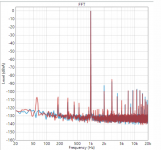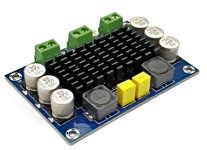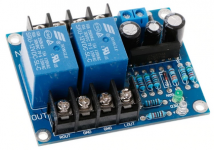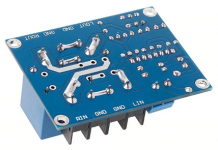.
If you are rational, you break free of this status perception and use a Volt+d or the like. Else, just follow the crowd.
I think I'm gonna split from the crowd and be rational. The confusion and mistrust in equipment caused by lack of quantification of audio quality with equipment in different price range was already running havoc in my brain a few days back.
Im gonna break free before this ocd takes over my mind and start chasing expensive stuffs which costs a kidney.
At least for now what's commonly available is thd.
Its been known for a good half-century that THD has nothing to do with perceived sound quality. One must look at the spectrum of harmonics at all signal levels.
Many people hear that there is something wrong with switching amps they have heard, and they aren't all crazy. Hysteresis distortion may be one of the important factors for those people. We don't know, its never been properly studied.
My only point is that switching amps don't sound like good linear amps to some very sane people who say they prefer the sound of linear amps. Maybe, just maybe, Bruno has finally solved the remaining problems while at Purifi. His business partner, Lars Ribo, still seems to think they may not have found quite everything yet. (He's the one who heard the amplifier hysteresis distortion and knew it sounded a problem he heard before when working on Purifi's transducer designs.)
The reason I am making the point now is that I only recently came across this thread. I saw there were a number of posts puzzling over and trying to find explanations for why some people say switching amps don't sound right to them. Now you have some more reasons to add to the pot.
Its been known for a good half-century that THD has nothing to do with perceived sound quality. One must look at the spectrum of harmonics at all signal levels..
By spectrum of harmonix do you relate to dynamic range. If yes I compared it aswell. The one I compared it to is 2700$ respected company amp. And that produced around 6db less dynamic range than the cheapo class d at 5w playback.
Spectrum analysis has been done in cheap class d but not in expensive one and results was commented as very clean.
Even if we talk about hysteresis distortion. With greater probability tube amp design seems to be more prone to it as they have alot of ferrite content in them which are constantly subjected to magnetic fields.
The 30 watts ultra linear class A tube power amp i used to have before had 3 huge transformers Which weighed atleast 5-6 kg.
But again these are just assumptions of mine regarding magnetic hysteresis
The 30 watts ultra linear class A tube power amp i used to have before had 3 huge transformers Which weighed atleast 5-6 kg.
But again these are just assumptions of mine regarding magnetic hysteresis
Who's Bruno, Lars Ribo and Purify?
Sorry for a couple of typos. Bruno Putzeys, Lars Risbo, Purifi: Purifi Audio
The 30 watts ultra linear class A tube power amp i used to have before had 3 huge transformers Which weighed atleast 5-6 kg.
Don't use tube amps myself, use Benchmark AHB2.
Spectrum analysis has been done in cheap class d but not in expensive one and results was commented as very clean.
What I meant by referring to the spectrum is that in harmonic distortion, as measured by FFT, different harmonics are perceived differently by humans. Low order harmonics, principally 2nd or 3rd, are not especially objectionable to most people. In fact many people don't hear them even at fairly high levels. On the other hand, higher order harmonics sound bad, usually the higher they are the worse they sound. Even though most people will never hear the 2nd harmonic of 10kHz, that's not necessarily what they would hear when listening. Stationary nonlinearities produce intermodulation distortion when music is played, since music consists of more than a single sine wave. IMD is generally more objectionable than HD, and tends to be produced at higher levels than the corresponding HD is. The main reason we measure HD is because it is easy to measure, and because it may be taken to imply corresponding IMD will occur with music. The reason THD+N was ever used is because it is the easiest of all to measure, not because it is particularly useful for predicting what an amp will sound like.
The reason for looking at the spectrum of HD at all signal levels is because it may be different at different levels. What an amp sounds like to humans depends on a lot of things, more information than we can easily digest. Even then we can't exactly predict how an amp will sound from measurements. Earl Geddes once tried to improve the situation by suggesting a new distortion metric that comes closer to being relevant to how humans hear. It never caught on though. So much for that effort.
Don't use tube amps myself, use Benchmark AHB2.
The review site uses your amp as their "the benchmark amp".
And about distortion at different frequency I will attach the screen shot.
And there was alot of information on your last post which was new and useful. Thanks
Attachments
FWIW, a vintage double-blind (ABX) test of amplifiers.
Really nice article.
It seems not many are worried by the monstrous amount of Rf radiated by class D speaker cables.
I can see class D integrated in active monitors, or as monoblocks in close proximity to speakers, but having 10m of speaker wire radiating a few hundred kilohertz into my phono stage inputs does not seem like a smart plan.
I can see class D integrated in active monitors, or as monoblocks in close proximity to speakers, but having 10m of speaker wire radiating a few hundred kilohertz into my phono stage inputs does not seem like a smart plan.
It seems not many are worried by the monstrous amount of Rf radiated by class D speaker cables.
I can see class D integrated in active monitors, or as monoblocks in close proximity to speakers, but having 10m of speaker wire radiating a few hundred kilohertz into my phono stage inputs does not seem like a smart plan.
Something you can cure with an output low-pass filter?
No, you can not. The filters certainly attenuate the issue but do not cure it as this would also kill efficiency. I believe there are a few hundred mV Rf at the output of Ncore.
FWIW...
Don't want to rekindle old arguments about such things, anyone feel free to PM if desired.
hi everyone. this is a long thread and really took some time to finish. i just got mine recently, a bluetooth version with the 'sanwu' wording behind, but not sure whether it is genuine anyway. so i am posting here to seek some advice.
the thing is, some picts on this thread are no longer available, some links lead to items no longer available on amazon or ebay or aliexpress. from what i can see, the layout/locations of the components on my board seems a bit different from the mono ones. so let's say i want to reduce the gain to 20db, do i still remove R27? do i have to fixed other issues like output bootstrap becos i dont see similar boards on this thread. not sure about the implementation on mine as i am not familiar with reading schematics. as far as my board goes, it doesnt have a mute option too, at least not printed on the board.


planning to use this in a boombox project with a pair of 3in or 4in speakers, not decided yet.
the thing is, some picts on this thread are no longer available, some links lead to items no longer available on amazon or ebay or aliexpress. from what i can see, the layout/locations of the components on my board seems a bit different from the mono ones. so let's say i want to reduce the gain to 20db, do i still remove R27? do i have to fixed other issues like output bootstrap becos i dont see similar boards on this thread. not sure about the implementation on mine as i am not familiar with reading schematics. as far as my board goes, it doesnt have a mute option too, at least not printed on the board.


planning to use this in a boombox project with a pair of 3in or 4in speakers, not decided yet.
Speaker Protection
Guys can you please advice? I'm putting back together my old amp with two mono TPA3116 D2 boards. I've taken the volume pots off and added a external volume and now fitting a speaker protection board. I've noticed it has grouped gnd. I have seen many reviews/builds saying this can cause issues.
PS I should have paid more and bought one with split gnd.
Guys can you please advice? I'm putting back together my old amp with two mono TPA3116 D2 boards. I've taken the volume pots off and added a external volume and now fitting a speaker protection board. I've noticed it has grouped gnd. I have seen many reviews/builds saying this can cause issues.
PS I should have paid more and bought one with split gnd.
Be careful, grounded protection board will fry your boards.
On those BTL/PBTL class-d amp neither of the speaker terminal are referenced to ground.
I think tpa3118 is an all embedded protection chip.
Wait for a confirmation though.
Perhaps check for BTL protection board.
On those BTL/PBTL class-d amp neither of the speaker terminal are referenced to ground.
I think tpa3118 is an all embedded protection chip.
Wait for a confirmation though.
Perhaps check for BTL protection board.
Be careful, grounded protection board will fry your boards.
On those BTL/PBTL class-d amp neither of the speaker terminal are referenced to ground.
I think tpa3118 is an all embedded protection chip.
Wait for a confirmation though.
Perhaps check for BTL protection board.
OK I thought as much hence asking.
These are my boards if that helps.
Attachments
Last edited:
I have the SANWU SW-HF48 and it worked initially (30mins) but then i swapped from the BT to the audio connection a couple of times, got a loud buzzing and then it appears to be shutting down and restarting due to the DC detect circuit (pops every second and DC output on left channel ramps up then falls). I did take off a resisitor from the gain circuit to drop it to 20dB but still no joy. If i short the input to the left channel chip pins the system goes into mono mode. If i short the L input before the coupling caps the restart still happens. Is this likely to be a fault internal to the TPA3118 chip or other component please?
- Home
- Amplifiers
- Class D
- Cheap TPA3118D2 boards, modding them and everything that comes with it



